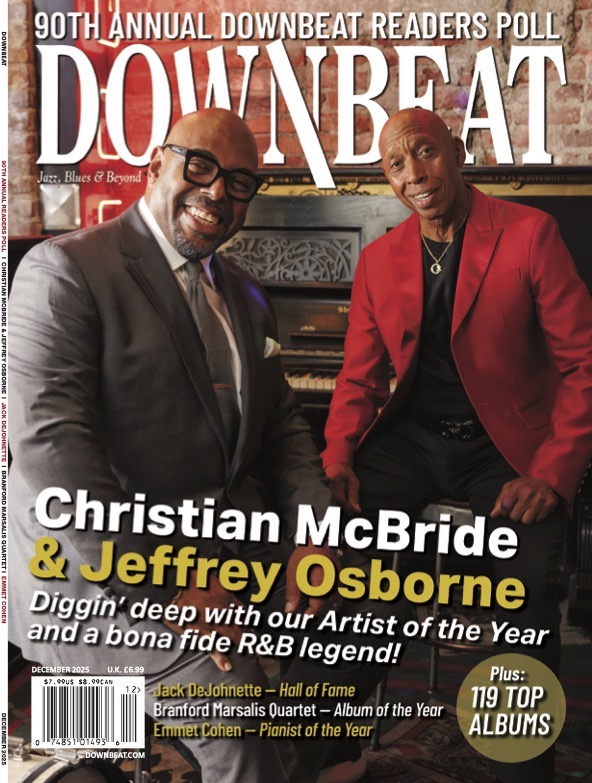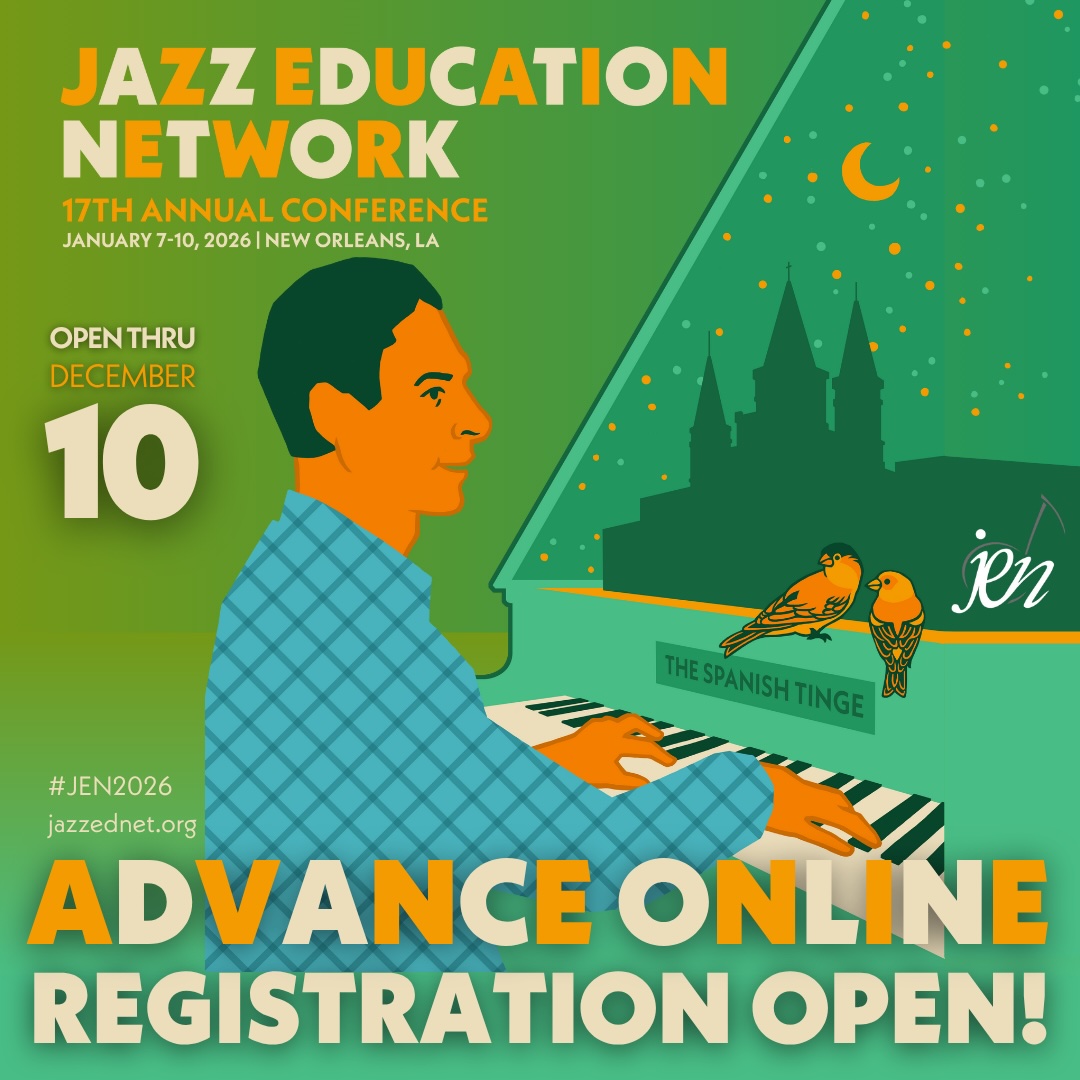Oct 28, 2025 10:47 AM
In Memoriam: Jack DeJohnette, 1942–2025
Jack DeJohnette, a bold and resourceful drummer and NEA Jazz Master who forged a unique vocabulary on the kit over his…
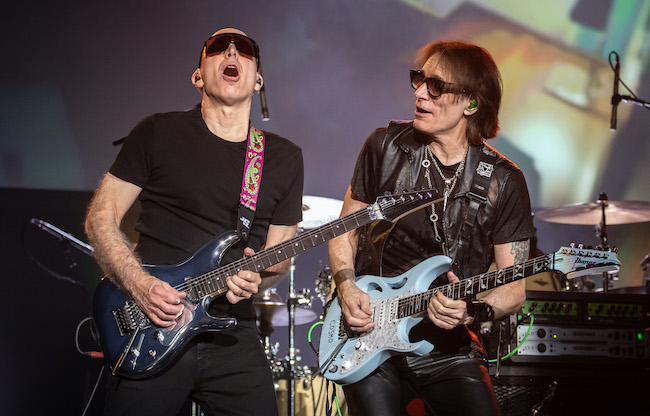
Joe Satriani, left, and Steve Vai are in the midst of an action-packed European tour.
(Photo: Jon Luini)They are the offspring of Jimi Hendrix, forever changed by hearing “Purple Haze” and “Voodoo Child (Slight Return)” while growing up on Long Island during the ’60s. On a recent video interview with Rick Beato on his popular YouTube channel, Satriani proclaimed Hendrix’s “Machine Gun” (from 1970’s Band Of Gypsys) “the greatest live performance ever on electric guitar, hands down!” Vai heartily agreed, calling it “the voice of God.”
And though Hendrix may have provided the impetus for their respective guitar experimentation — the match that lit the fuse — each of them would go on to achieve a kind of staggering virtuosity on the instrument, marked by unprecedented speed, mind-boggling technique, melodic invention and a willingness to push the envelope, that raised the bar for instrumental rock guitar in the ’80s and ’90s.
The two chopsmeisters have been friends for over 50 years, going back to when Vai began taking guitar lessons with Satriani in 1973 when they both attended Carle Place High School on Long Island. They would later go their separate ways — Satriani leaving for the San Francisco Bay Area near the end of 1975, Vai to Boston’s Berklee College of Music in 1978 — and ultimately achieve fame for their separate endeavors. Vai would become a valued member of Frank Zappa’s band from 1980 to 1983, appearing on such pivotal albums as Joe’s Garage, Tinseltown Rebellion, Them Or Us, You Are What You Is and Ship Arriving Too Late To Save A Drowning Witch as well as the all-instrumental Shut Up ’n Play Yer Guitar. In concert, Zappa would alternately refer to Vai as a “stunt guitarist” whose job it was to provide “impossible guitar parts,” while also calling him “our little Italian virtuoso.”
Vai’s “in” for that gig with Zappa came during his stint at Berklee, when he sent the demanding and often irascible auteur letter-perfect transcriptions of Edgard Varese’s music along with Zappa’s own notoriously difficult instrumental, “The Black Page.” In the middle of his fourth semester at Berklee in 1979, Vai would move to California, just down the street from Zappa, who put him on salary as his official transcriptionist before he eventually joined the band in late 1980. Vai’s subsequent stints in the ’80s with Alcatrazz, Whitesnake and the David Lee Roth Band (replacing guitar hero Eddie Van Halen in the lineup) elevated his status in the guitar world. In 1996, he would reunite with his former teacher Satriani for the first of several G3 tours featuring a third special guest guitarist. The inaugural tour featured fellow guitar virtuoso Eric Johnson, and subsequent G3 tours would pair Satriani and Vai with such guitar stars as Dream Theater’s John Petrucci, neo-classical metal god Yngwie Malmsteen, King Crimson’s Robert Fripp and Steve Lukather. Last year, they reunited with original G3 member Johnson.
Along with all that activity, Vai has released a dozen albums as a leader, beginning with 1984’s Flex-Able and including 1990’s Passion And Warfare, 1993’s Sex & Religion, 1996’s Fire Garden, 2005’s Real Illusions: Reflections (the first installment in an ongoing three-part trilogy concept album), 2012’s The Story Of Light (part two of the trilogy) and 2016’s Modern Primitive, which contained the jazzy tune “Bop!” His most recent outing was 2022’s Inviolate, on which he unveiled his three-necked Hydra guitar (named for the many-headed serpent-like beast defeated by Hercules in Greek mythology), which accounts for part of the name of his upcoming “Surfing with the Hydra” tour with Satriani.
Satriani’s debut as a leader, 1986’s Not Of This Earth, introduced his remarkable virtuosity and two-handed tapping skills on tunes like “The Headless Horseman,” “Hordes Of Locusts” and “Ice 9” to an eager audience of slack-jawed guitar enthusiasts. But it was the mainstream success of 1987’s Surfing With The Alien that broke Satriani through a new level of visibility, along with a stint the following year in Mick Jagger’s band for his She’s the Boss tour, the singer’s first solo endeavor outside of the Rolling Stones.
Satriani has since recorded 18 albums as a leader, including 1995’s Joe Satriani (which includes the persuasively swinging “Killer Bee Bop”), 1998’s Crystal Planet, 2002’s exotic Strange Beautiful Music, 2010’s more experimental Black Swans And Wormhole Wizards and 2020’s brilliant Shapeshifting. His most recent recording is the wildly imaginative 2022 pandemic project The Elephants Of Mars, which contains his jazziest song to date in “E. 104th Street NYC, 1973,” a nod to his time studying with guitarist Billy Bauer and pianist-composer Lennie Tristano when he was still living on Long Island.
Satriani and Vai reunited in 2024 for their international “Satriani/Vai” tour, performing separate sets with their respective bands before joining for an encore on a few hair-raising jams. Their tour this summer through Europe and later this year in the States will mark the debut of their SatchVai Band (backed by bassist Marco Mendoza, guitarist Pete Thorn and drummer Kenny Aronoff) and showcase new material they co-composed for an album to be released in 2026. They’ve already released two singles from that upcoming release — “The Sea Of Emotion, Pt. 1” and the anthemic “I Wanna Play My Guitar,” the latter featuring Deep Purple vocalist Glenn Hughes.
DownBeat caught up with the longtime friends and fellow six-string marvels separately as they were preparing to hit the road independently — Vai going out on tour with the King Crimson tribute band BEAT, Satriani doing a nine-date Las Vegas residency with Sammy Hagar — before reuniting for their electrifying “Surfing with the Hydra” tour.
Bill Milkowski: I first saw you at Zappa’s Halloween show at the Palladium in 1981 and then again a couple of weeks later at the Ritz when Frank brought Al Di Meola out as a special guest and introduced him as “another great Italian.”
Steve Vai: Oh, wow! That’s going all the way back.
Milkowski: And I’ve been following your career ever since through all your different situations over the decades. But the story of your ongoing friendship with Joe Satriani is one for the ages.
Vai: It’s kind of a miracle. Joe and I look back at our joined-at-the-hip careers and it’s just phenomenal the way everything has worked out. Last year we wanted to extend the G3 tour but Eric Johnson had scheduling issues, so Joe and I decided to hit the road as two separate bands. And we didn’t want to call it G2, so we went out as the “Satriani/Vai” tour.
And we thought we should have a new piece of music for this tour, so Joe wrote two tracks and sent them to me — “The Sea Of Emotion, Pt. I and Pt. II.” I thought they were fantastic, and I wrote the third part of that three-movement suite. And that’s when the light bulbs started going off. You know, “We haven’t done this before, and we’ve always talked about doing this. Maybe now’s the time. Let’s make a record!” And it just organically developed from there.
Milkowski: How did the process begin?
Vai: We started sharing files, and it was just such a wonderful discovery of how nicely co-creative it is working together. Joe and I are similar in many ways, or we kind of play in the same playground, to a degree. And he also taught me how to play, so a lot of those similarities are apparent. There’s a lot of crosstalk when we play because our techniques are not so wildly different. I mean, it’s not like he’s a classical player, and I’m a jazz player; we’re both rock players. But our musical DNA is different. When you listen to Joe’s catalog, it’s very distinctly Joe. And when you listen to my catalog, it’s me. It’s my interest in music being manifested. That’s what every artist does. So bringing those two musical DNAs together really creates a sweet spot. The songs are just turning out great and we’re looking really forward to eventually getting the record out.
Milkowski: You have such a nice blend together. Aside from being virtuosos, you’re both melodic players.
Vai: Yeah, we both love melody. And for me, every time I am able to figure out how to get the melody, the bass and the chords into a seamless piece of music, it’s just like a surprise and delight that keeps you going. Every time you get something to line up nicely, you get a little dopamine rush.
Milkowski: How did you come by your incredible work ethic over time? Whether it was doing transcriptions for Zappa, playing the impossible guitar parts in his band, or creating your own outrageously challenging music, you’ve always demonstrated a willingness to tackle challenges.
Vai: It’s just a deep interest and enthusiasm for a good idea. And I always seem to be attracted by challenges. Like all that Zappa music I transcribed and played, that was a challenge. Replacing Eddie Van Halen in the David Lee Roth band — you know, being the guitar under the voice that most people knew as Edward — that was the challenge. Then launching a solo career and doing something like Passion And Warfare, that was a challenge. And then when the BEAT gig came along, that was a challenge. And I just said yes to all of it. I don’t know why, but I just like doing difficult things. I was working 13 hours a day on those transcriptions for Zappa and loving every minute of it. Because when you find something that’s really interesting to you, you don’t need discipline. It just happens in and of itself. Your interest is enough. So really I just chase good, compelling ideas.
Milkowski: Was that instilled in you when you were taking lessons as a kid with Joe Satriani?
Vai: Joe fueled it because he was giving me the tools to discover more, allowing me to expand my enthusiasm of the instrument, so to speak. It was always there, for some reason. The interest in doing something and enjoying it ... that was always there. I’m terrible at doing things I don’t want to do. I have no discipline. But with the guitar, it was always a wonderful kind of a journey for me.
Milkowski: How did you forge your relationship with Joe Satriani back in the early ’70s?
Vai: I was 12 when I started taking lessons with Joe, so it’s been about 52 years that we’ve known each other. I was always enamored with the guitar but I never actually started playing it, because I always saw it as this sacred thing that I was unworthy of touching, until finally I heard Led Zeppelin. And that’s when I decided, “I gotta play the guitar.”
My friend down the street, John Sergio, was taking lessons from Joe and he gave me Joe’s number. And I had this little Tesco Del Rey guitar at the time and didn’t know anything about it. I didn’t know how to change the strings or anything. So I would just play it, but I didn’t know what I was doing at all. I’d break a string and keep playing, and it got to the point where I only had like two strings on the guitar. So I saved up from my paper route money and bought some strings and started taking lessons with Joe. And those lessons were sacred to me. That’s all I gave my attention to. I took lessons from him for like three years on and off, because he was going in and out of town at that time. And eventually Joe and I really created a bond when I was relatively mature enough to musically communicate. He nurtured that out of me.
Milkowski: How did your lessons with Joe evolve over time?
Vai: After learning the fretboard, our lessons eventually turned into these glorified jam sessions. We’d sit in his backyard, literally back to back, and just play electric guitars with no amp, sitting under the tree. And I clocked one of those jams at six hours. Going that deep with somebody musically requires intense presence of listening and responding. And you’re not going to just respond with scales and riffs that you already know. After a while, that gets really boring and repetitive. So we pushed each other. We just explored, explored, explored. And I developed my listening ear through those experiences. And I also developed with Joe our connection, which never left us. That’s always been there. And it’s evolved because now when Joe and I are just exchanging and playing together, freewheeling, it’s remarkable to us how funny some of the ways that we connect are. It might be our own little secret, but it’s really rewarding. It’s tremendously fulfilling to do that.
Milkowski: This upcoming tour and album mark the first time that you and Steve Vai will tour together as a band. And you’re also writing songs together. How has that been going?
Satriani: I enjoy that process of creating. It’s cathartic, and it drives me crazy, but it’s really fun. Working on this album with Steve now is a perfect example of that, where the two of us are throwing songs back and forth to each other, and it just puts us in this spot where we’ve never been before, where we wouldn’t have been had we not agreed to push each other and our individual limits, just to see what would happen. So we come up with things we would have never have come up with if the other partner had not pushed us into some new creative space. And as we go over the songs, the ones that stay on the list are the ones that have strong melody and interesting harmony that we think is innovative in some way. And then, of course, we’re just goofball guitar players, so we also just love to throw guitar-y things back and forth to each other, just for fun. It’s that old question of, “What can I do with my fingers on these strings that I haven’t done before?” We both like that whole process of questioning what we’ve done before and trying to come up with something different.
Milkowski: What were your lessons like?
Satriani: Steve was physically gifted to play the guitar, and he progressed so fast it was amazing. He went from beginner to advanced in like six months. So by the time he was about to go to Berklee, there was not much else that I could teach him. He had already mastered all the scales and all the chords. That was the one thing that was so great about teaching Steve: He did his homework, and he was so eager to make music that he would learn everything.
I mean, he excelled so quickly that we didn’t have to spend much time working on the fingerings. After we got over the informational hump of where are the notes, what are the names of the scales, when do you use them, what are names of all the chords and can your fingers play them, it became all about, “How do you express it?” And we could sit around and just talk about, like, how to play more sad. What’s really sad, what’s happy, what’s in-between?
So we spent a lot of time trying to figure out what modes we would want to use to make people feel a certain way. I remember there was a book out, Psychology of Music, that really was focusing on how to use scales and intervals and chords to evoke emotion. It was very much like what a soundtrack composer would do on their job — putting music to a particular scene that a director gives them.
But it was all really interesting stuff at the time because we had already jumped over those hurdles of what are the scales, where can you play them, and how fast can you play them. We were both advanced players by then, but you can arrive at that point and still not know how to make people happy with music. And Steve and I knew that was primarily our job. Part of it is making ourselves happy, but the most important part is giving music to people so they can use it in their lives. So we do have to get a hold of the effect of our notes and how they affect people.
Milkowski: How did Vai seek you out for lessons?
Satriani: I was teaching a bunch of people at the high school we both attended in Carle Place. I had been asked to leave Catholic school because I was a troublemaker, so I convinced my parents to send me to public school. That’s where I thrived, at Carle Place High. Anyway, I started playing high school dances and backyard parties, and other kids started to ask for lessons. I think I even gave a couple of teachers at the high school lessons as well. One of Steve’s good friends, John Sergio, was a student of mine. And I think at some point John said, “Oh, you gotta go see Joe.” That’s how it began.
Milkowski: Although your music is very intense, you’ve had acoustic moments over time where you’re very tastefully letting it breathe on some of your phrasing.
Satriani: Oh, I think it’s so important that when you’re playing any piece of music for somebody, you’re trying to get them to feel, to imagine, to inhabit the story behind the song, so you try to touch on all kinds of textures. Whether it’s like a song like “Tears In The Rain” [from 1995’s Joe Satriani] which is pretty minimal, or if it’s somewhat whimsical, like “Yesterday’s Yesterday” [from 2020’s Shapeshifting], I don’t ever discourage myself from playing simply, if that’s the part that puts a smile on your face.
The level of difficulty should have nothing to do with how you feel about the quality of the music or how it makes you feel on an emotional level. I guess I hold in my heart things like “Moonlight Sonata” and “Sleepwalk” and I think, “These are unbelievably beautiful pieces of music that are not technically difficult. They don’t shine a light on the performer like, “Hey, look what he can do!” It’s not about that at all, it’s all about the music. That’s kind of like me in a nutshell.
Milkowski: And you actually recorded that classic 1959 Santo & Johnny tune, “Sleepwalk,” on your 2002 album Strange, Beautiful Music.
Satriani: Yeah, I actually talked to Johnny (Farina) about that before I recorded it because I wanted his approval. I just wanted him not to be offended, because you really can’t play it on guitar. There’s no way to reach the harmonics the way he did it on lap steel. But “Sleepwalk” is my earliest memory of being mesmerized by music. That song, to me, is just so beautiful that you’re not even thinking about the person as a technician. It creates an instant memory.
Milkowski: So, for you, “Sleepwalk” came before Hendrix and Led Zeppelin.
Satriani: Yeah, I have a really strong memory of it. I’m in the backseat of my parents’ old ’49 Dodge. The car was falling apart and the radio was on. And I remember every time that song came on, it was a golden, magical moment for me. I just thought the whole thing was ... that was the world I wanted to inhabit. DB
The musical lineage from teacher to student passed from Joe Satriani to Steve Vai. On the flip of that, two of Satriani’s influential teachers were jazz pianist Lennie Tristano and guitarist Billy Bauer.
Bill Milkowski: On your 2022 album The Elephants Of Mars, there’s a distinctly jazzy element on the track “East 104th Street, New York City, 1973.” Where does that come from?
Joe Satriani: Those are my memories. When you’re in a studio you tend to want to be professional and play things that can be recorded at the moment and are usable. But when you’re in your home studio and there is no deadline, which was the case with The Elephants Of Mars, which was done during COVID lockdown, you tend to drop all that and start to entertain different creative pathways of expressing yourself. And because I’m not thinking about the end result in that situation, I’m only thinking about the moment of expression. And that really opens up the creative floodgates.
Milkowski: That jazzy aspect also comes across on the track “Killer Bee Bop” [from Satriani’s 1995 self-titled album], which is underscored by Nathan East’s uptempo walking bass lines and drummer Manu Katche’s swing factor on the kit.
Satriani: Again, that was me harkening back to my teenage years; that brief period where I was studying with Lennie Tristano and just coming to grips with what the bebop generation had created, what they had achieved.
Milkowski: Can you talk about your time with Tristano?
Satriani: I was attending Five Towns College, and I was very discouraged by the kind of education I was getting there. And one day I was complaining to a schoolmate and said, “I’m not cut out for school anymore. I’m looking for a genius to teach me the mysteries of music.” And he says to me, “Oh, you have to go see Lennie.” And I’m like, “Who’s Lennie?” I literally did not know who Lennie Tristano was at that point. And after he berated me for not knowing who Lennie Tristano was, he told me the whole history of Lennie and said, “He lives right over in Queens, like 20 minutes from your house. He’s exactly what you’re looking for. I’ll get you his number.” Then he warns me: “He’s really tough, though.” But I was just so ready for him at that point.
What I learned from Lennie Tristano was what being a musician is really about. What I had been doing was playing with the idea of being a musician, until I met Lennie. And then I realized, “Damn, I really don’t know what I’m doing.” And Lennie’s thing was, “Learn everything so you never have to think and be judgmental while you’re playing, because that means you’re not in the moment. So you’re not improvising.”
It was the opposite of what people were thinking around that time, which was, “Do whatever you want, be free.” But that wasn’t what he meant. His whole thing was learn everything, know everything, learn how never to make a mistake. But don’t you dare think about anything when you’re improvising. Just be in the moment.” And that’s the hardest thing in the world to do. It’s easy to practice something and then stand up and perform it. But to perfectly improvise, that’s a zen state of mind, born out of the soul of Lennie Tristano.
Milkowski: You must’ve heard recordings by Tristano’s band with Lee Konitz, Warren Marsh and guitarist Billy Bauer.
Satriani: You know, I actually took lessons from Billy Bauer before I studied with Tristano. Here’s how that happened: I had been complaining to my mother that I was frustrated searching for information about music. This was before the internet or instructional videos or anything, so it was really hard to find people to teach you certain things about music. And I don’t know how she knew that Billy Bauer taught not far from us. We lived in Westbury and he lived in Glen Cove, which was pretty close.
So she drove me to a couple of lessons at Billy Bauer’s house. I remember after my first lesson with him I came back home and thought, “Wow, this guy is heavy. I gotta find out who he is.” But it was really hard to find the albums back then. Again, there were no streaming services. None of my friends knew who Billy Bauer was and my parents didn’t have any Tristano albums. So that made it difficult. But eventually I did start to listen to the albums that Billy Bauer made, and I was shocked at the modernity of it all. He was the first one that showed me three-octave scales and different arpeggio exercises. I only lasted about three weeks with him, but it’s very interesting that my path would cross with Billy Bauer before Lennie Tristano. DB
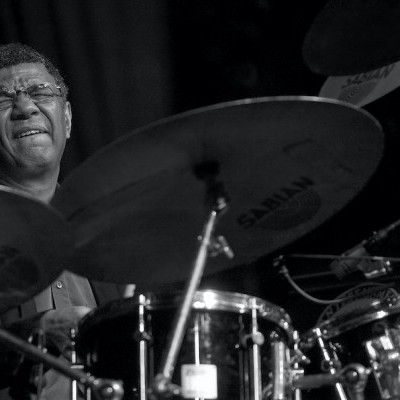
Jack DeJohnette boasted a musical resume that was as long as it was fearsome.
Oct 28, 2025 10:47 AM
Jack DeJohnette, a bold and resourceful drummer and NEA Jazz Master who forged a unique vocabulary on the kit over his…
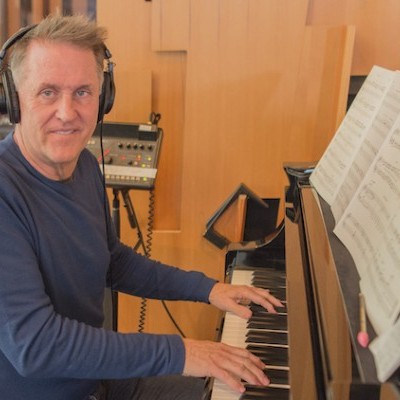
Goodwin was one of the most acclaimed, successful and influential jazz musicians of his generation.
Dec 9, 2025 12:28 PM
Gordon Goodwin, an award-winning saxophonist, pianist, bandleader, composer and arranger, died Dec. 8 in Los Angeles.…
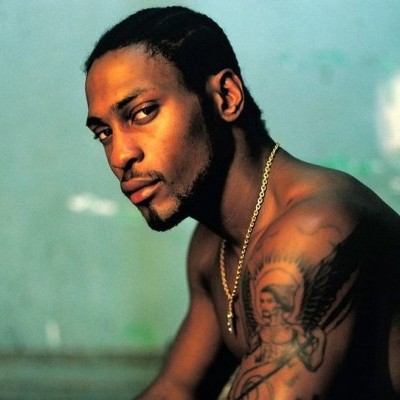
D’Angelo achieved commercial and critical success experimenting with a fusion of jazz, funk, soul, R&B and hip-hop.
Oct 14, 2025 1:47 PM
D’Angelo, a Grammy-winning R&B and neo-soul singer, guitarist and pianist who exerted a profound influence on 21st…
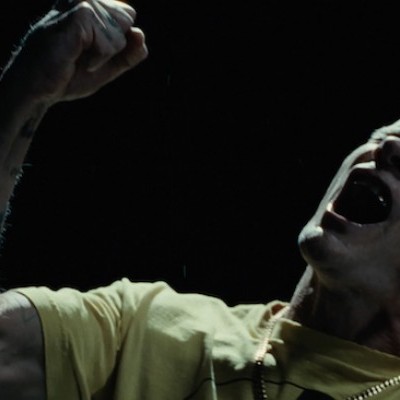
Flea has returned to his first instrument — the trumpet — and assembled a dream band of jazz musicians to record a new album.
Dec 2, 2025 2:01 AM
After a nearly five-decade career as one of his generation’s defining rock bassists, Flea has returned to his first…
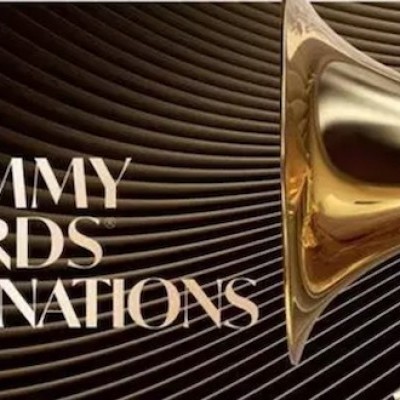
To see the complete list of nominations for the 2026 Grammy Awards, go to grammy.com.
Nov 11, 2025 12:35 PM
The nominations for the 2026 Grammy Awards are in, with plenty to smile about for the worlds of jazz, blues and beyond.…

